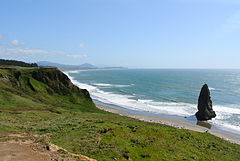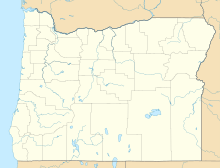Cape Blanco (Oregon)
| Cape Blanco State Park | |
|---|---|

View from Cape Blanco, looking south towards Port Orford Heads State Park. Humbug Mountain in the distance.
|
|
| Type | Public, state |
| Location | Curry County, Oregon |
| Nearest city | Port Orford |
| Area | 1,880 acres (760 ha) |
| Operated by | Oregon Parks and Recreation Department |
| Visitors | Annually, about 350,000 for day-use, 35,000 overnight |
| Open | Year-round |
Cape Blanco is a prominent headland on the Pacific Ocean coast of southwestern Oregon in the United States, forming the westernmost point in the state. Cape Blanco extends further west than any point of land in the contiguous United States (lower 48 states) except Cape Alava, in Washington. The cape is part of Cape Blanco State Park and is the location of the Cape Blanco Light, first lit in 1870.
The cape may have been named by explorer Martín de Aguilar in 1603 for its appearance, as blanco means "white" in Spanish. In 1775, Juan Francisco de la Bodega y Quadra named the point Cabo Diligensias. It was later renamed Cape Orford by Captain George Vancouver in 1792 but this name fell into disuse and Cape Blanco became the common usage.
The cape, a relatively level landform with cliffs facing the sea, is about 200 feet (61 m) higher than the ocean. It consists of layers of uplifted marine sediments, ranging in age from 80 million years at the bottom to less than 500,000 years at the top. The uplift is continuing; Cape Blanco is rising by several millimeters each year. Generally, landforms on the north and south end of the Oregon Coast are rising as the ocean floor slides under the continent, while the central part of the coast "seems to be folding down."
Landforms near the cape include beaches, bluffs, and reefs. Visible to the south are Needle Rock, Blanco Reef, and Humbug Mountain. To the north are Gull Rock, Castle Rock, and Blacklock Point. Blanco Reef is a group of irregular rocks and ledges that are from 2 to 5 miles (3 to 8 km) offshore and are up to 149 feet (45 m) high.
Cape Blanco is in northern Curry County, about 4 miles (6 km) north of Port Orford, along a mountainous and isolated stretch of the coast bounded to the east by the Coast Range. It lies about 5 miles (8 km) west of U.S. Route 101.
...
Wikipedia

